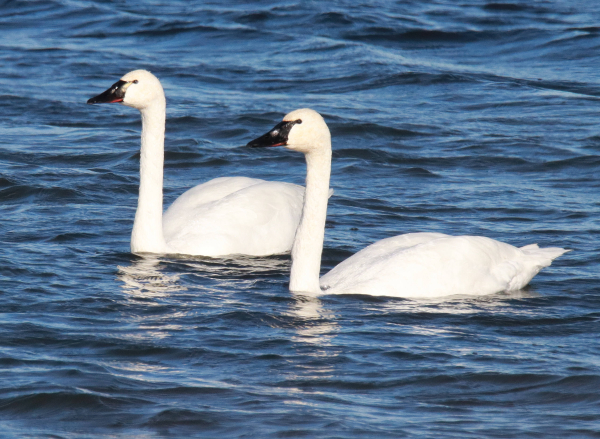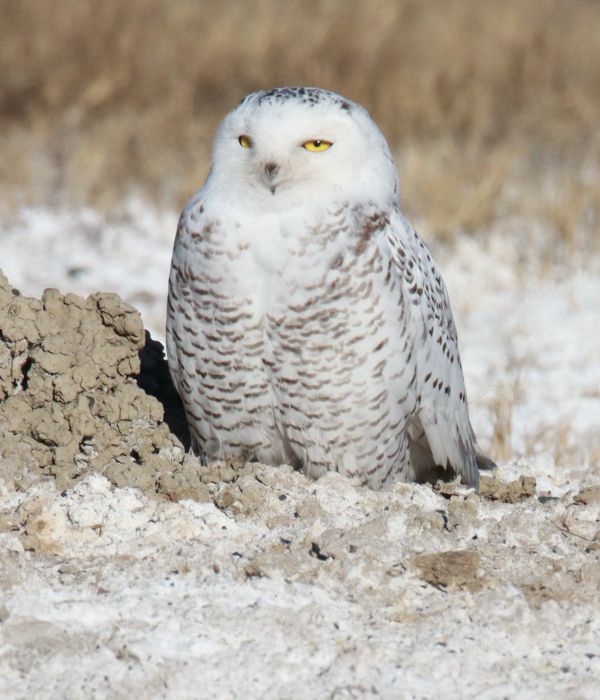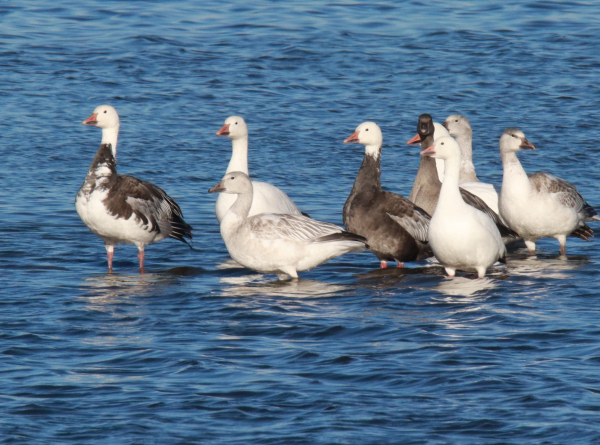
A tranquil portrait of a pair of Tundra Swans taken Sunday may be the last of this majestic species for this year in Dakota-land with the advent of winter weather Tuesday.

Of course, the first Snowy Owl of the season was a singular thrill, and the chance to photograph it made it the first photo opportunity in a few years. See and read more about this chance encounter in the Bird Photography feature in this issue.

Small flocks with a mix of Snow Geese and Ross’s Geese began to lift off Napolean Lake to feed in nearby harvested cornfields. Five species of geese have fueled this late fall season, with large flocks numbering in the thousands creating memorable observations.

A variety of plumage types of Snow Geese are represented in this small group, including a hybrid white and blue morph Snow at left, adult and young white morph Snows, plus a blue morph adult and juvenile.

A close-up of a female Northern Shoveler is emblematic as 1 of more than 600 encountered in a feeding concentration at Long Lake Refuge.
|
Seeing a new bird is exciting, seeing a rare bird is just as exciting; but seeing a Snowy Owl and sharing moments one-to-one is a whole different level of exciting, one that stays with you for days, and if you get photographs, they will remind you of the Snowy encounter for the rest of your life. Snowy Owls are among of my favorite birds, and I was a bit charged up after reading the new report from Project Snowstorm, described in the above Birding News article, that this should be a good winter to see Snowy Owls. As I headed west to Napolean Lake last Saturday afternoon, when least expected, I thought I saw a partly hidden, shadowy form that could be a Snowy Owl!
Yes! And could I get into position to photograph it? The Snowy had its shadowed back facing toward the roadway, so I would need to approach it on foot to be in position with the sun at my back and illuminating the white owl. The white owl was perched on white bare ground on the edge of a small drying alkali marsh, and a small hill gave me cover to get within camera range, so I gave it a try. As I rounded the hill and saw the owl in perfect light I hoped it would trust me from a distance. But its attention was elsewhere, and with its head turned it hadn’t seen me yet, which gave me a moment to get into position for a few photos, which I began to take as it turned its gaze toward me, then away again – WoW! I’ll share the rest of this surprising story and more photographs in the Bird Photography feature at the end of this issue – hope you like it.
Westward Ho!
Last Thursday afternoon I headed 90 minutes west to the Missouri River to check for Whooping Cranes again, but foremost I was checking on how bird migration and stopover activities changed along what has become a weekly birding drive. Local geese concentrations appeared to be holding steady at many thousands, but the 3 mile long lake that’s located less than a mile northwest of home surprised me with about 78 Tundra Swans present. Indeed, that’s the way the afternoon proceeded with similar waterfowl numbers at some lakes, and new huge flocks or vastly larger flocks at other lakes.
Eight miles on down the road, an unnamed lake that has been a stopover for Tundra Swans held only 2 swans, barely noticeable among thousands of Snow Geese with hundreds of Ross’s Geese likely mixed among them. At Train Lake, 7 miles farther, I was surprised by a huge flock of more than 1,000 Snows and Ross’s Geese tightly packed on the water. I appreciated a chance to photograph portions of the flock in beautiful blue sky sunlight, and kept moving – it was still a long distance to the Missouri River. Another unnamed lake about 10 miles to the north held about 65 Tundra Swans, with about 20 close to the road that required me to take a little extra time to photograph family groups and pairs.
Cindy’s Lake was next, a stronghold for swans, which increased by 50 percent to about 150, but the real news there was a couple thousand Snow Geese on the water – the lake was very much alive with big white birds. Wentz Lake was next, and while it started out as the wetland with the largest concentration of geese each time I have stopped there this fall, I must have gasped when I saw the extent of Snow Geese and Ross’s on the water and adjacent feeding fields as the birds in flight changed the complexion of the sky to a lighter shade of gray-blue near the north shore. There were also 110 Tundra Swans on the water, with some swans taking low flights above the lake – a long distance away.
How was Napoleon Lake going to beat that mega-concentration of waterfowl? By the fact that the geese were more diverse and much closer to provide some exciting photo opportunities. First there were a lot more Snow Geese with Ross’s, and 3 large flocks of a hundred or more White-fronted Geese were present. There were less than 20 Tundra Swans, but 4 were positioned very close with a large mixed flock of geese that allowed me to get close and take photos at will, with many geese swimming along the edge of a bay and the swans swimming in the midst of it. That’s when the afternoon really became fun and exciting all at once.
Eventually I moved to a second spot a couple hundred yards to the west, where the large flock of geese was beginning take flight to feed in a nearby field. Just seeing the geese taking flight in groups of 10s and 20s in an almost continuing fashion was exhilarating, as were their collective sounds, so I took a series of photographs of that action too. Of course there were Cackling and Canada Geese on hand too, but surprisingly few considering the volume of thousands of Snow Geese. On the way to the Missouri River, I decided I should take a little detour to check Long Lake National Wildlife Refuge to see if Sandhill Cranes and the variety of geese were flocked in there, as I was sure they were.
That said, there were no cranes, and Canada Geese were the only goose representatives, but there was a surprise – about 600 Northern Shovelers were concentrated, filter feeding on the expanse of a roadway that divides a section of the lake. There were also 4 Sharp-tailed Grouse, and a scattering of Ring-necked Pheasants, usually as single birds, but a surprise group numbered 14, and another numbered 5; but the refuge was almost waterfowl-less, aside from the abundance of shoveler ducks. On to the river!
There was only an hour of sunlight remaining before I realized that not a single raptor showed that afternoon, but almost as soon as the thought came to mind it was revoked by a look at an adult Bald Eagle perched in a tree near a collapsing historic log cabin. I drove the river road south about 20 miles, then retraced the highway north again without seeing a trace of a crane – Whooping or Sandhill, much less flocks of them such as I enjoyed last fall. Little consolation was seeing a Black-billed Magpie, although that’s the first magpie I’ve seen in a long time, partly because they are rare on the east side of the Missouri River, and I am rare on the west side these days.
The sun already set by the time I considered if I could make it to McKenzie Slough before dark, but with the poor showing of birds after Napolean Lake I didn’t have much hope – but gosh was I surprised. It was almost dark after I counted the 220 Tundra Swans toward the southwest edge of the open water, and a bit farther along, as I was about to make a U-turn on the gravel road, thousands of geese began to rise into the last light in the western sky!
It was hard to imagine these were Snow Geese because Snows really aren’t a regular stopover species at McKenzie, but as small flocks flew toward the area where the swans were located, I hopped out of the car to listen for the calls – Snow Geese for sure! Two weeks earlier there were about 1,000 White-fronted Geese here, but not a Snow to be seen. Boy did things ever change in the meantime!
Closer to home, 2 huge flocks of geese continue to populate the area, 1 less than a mile south and 1 less than a mile east, which means the sights and sounds of Snow Geese continue each day, but for how long is yet to be determined. The mega-flock to the south tends to rest, drink, and bath at Melody’s Marsh, just a half-mile south, and I was thrilled to see a flock of hundreds flying in to feed in a harvested cornfield just a few hundred yards south of home – how can you beat that, when paired with the surprise sighting of a Snowy Owl?
New Feeder Birds & the Big Chill – Speaking of close to home, I continue to have 3 different Red-breasted Nuthatches visiting my feeders, along with Blue Jays, House Finches, 2 White-breasted Nuthatches, and the male Hairy Woodpecker. That species list was static until, after an absence of the species for a week, 2 American Goldfinches appeared Monday morning. And with a change of weather on the way, the first Pine Siskin of the season showed up at my feeding station too. During the next few days it will be interesting to monitor my feeding station for the possibility of more new bird activity, ‘cuz a change is comin’.
With a blizzard raging today (Tuesday), it will be mighty cold by Thanksgiving Day, when the highs will be in the low 20s temperature-wise with overnight temps dropping into the teens, so ice will overtake the surface of all area marshes and lakes until only Carlson Lake will have open water. The remaining geese tend to press into this last surviving icy-cold deep water, which sometimes concentrates hundreds of thousands of Snow Geese and representative numbers of the other 4 species, plus late-season ducks. Bald Eagles will likely appear in numbers, but every year is different. The geese and ducks and eagles bring the action to a crescendo, until the bottom falls out and they all leave one cold windless night. It takes birders to a high point, then drops us down to zero. It’s an abrupt ending to a super fall migration period. But every year is different, so it will be interesting to follow the changes day to day.
And then what? We wait for the next Snowy Owl! Considering indications that this will be a good year for Snowys to move south this year, there will likely be more sightings during my wanderings through the 3-state region. And my winter season attentions will return to the Sax-Zim Bog and my SoDak Raptor Surveys, as well as more local birding drives. Judging from the snow falling as I prepare to publish this issue of The Birding Wire, winter has been forced upon us in the northern plains. As for the big freeze, I will have the shakeout for you in next Wednesday’s update. I hope you have a wonderful Thanksgiving period that includes some birding opportunities.
Article and Photos by Paul Konrad
Share your bird sightings and photographs at editorstbw2@gmail.com